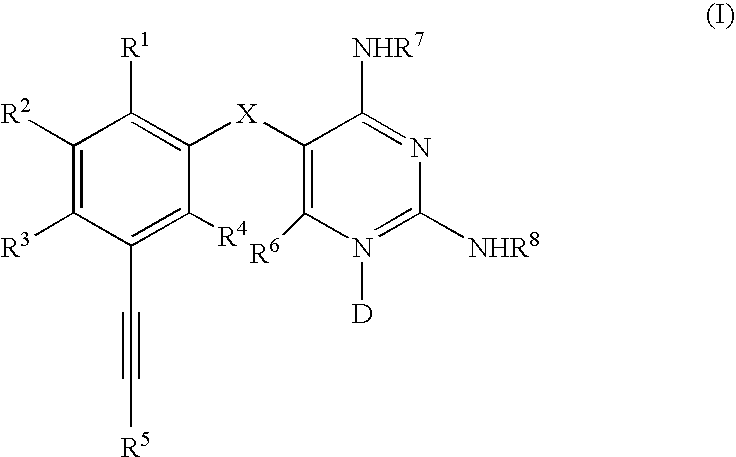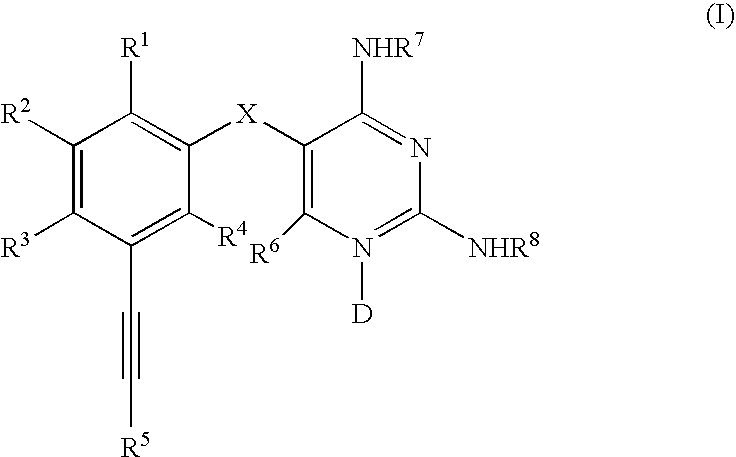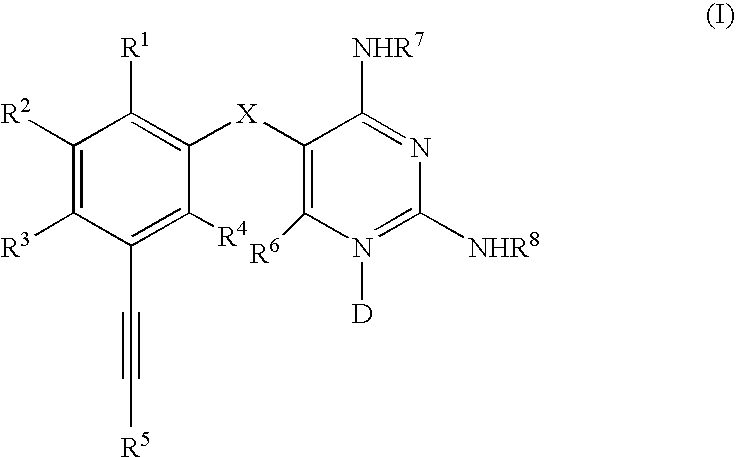Diaminopyrimidines as P2X3 and P2X2/3 modulators
a technology of diaminopyrimidine and p2x2/3, applied in the field of compounds, can solve the problems of intense pain and pronounced increase of sensory nerve discharg
- Summary
- Abstract
- Description
- Claims
- Application Information
AI Technical Summary
Benefits of technology
Problems solved by technology
Method used
Image
Examples
example 1
5-(5-Ethynyl-2-isopropyl-4-methoxy-phenoxy)-pyrimidine-2,4-diamine
[0654]The synthetic procedure used in this Example is outlined in Scheme C.
[0655]
Step 1 2-Isopropyl-4-methoxy-phenol
[0656]To a cooled solution of 1-(2-Hydroxy-5-methoxy-phenyl)-ethanone (10.0 g) in 80 mL of THF was gradually added 46.4 g of 3M solution of MeMgCl in THF at a rate such that the reaction mixture temperature did not exceed 25 degrees C. Following addition of the MeMgCl solution, the reaction mixture was stirred at ambient temperature for 18 hours. To the stirred solution was then added 10% palladium on carbon (1.02 g, 50% water wet) suspended in 4 mL of THF. The reaction mixture was placed under a hydrogen atmosphere at 5 psig and cooling was applied to maintain a temperature of approximately 25° C. To the cooled mixture was gradually added concentrated HCl (20 mL) while maintaining the reaction temperature at 25° C. The resultant mixture was stirred at ambient temperature for 18 hours, then treated with ...
example 2
4-(2,4-Diamino-pyrimidin-5-yloxy)-2-ethynyl-5-isopropyl-phenol
[0662]
[0663]5-(2-Isopropyl-4-methoxy-5-trimethylsilanylethynyl-phenoxy)-pyrimidine-2,4-diamine (0.65 g, 1.75 mmol) was added to 40 mL methylene chloride at ice bath temperature and under nitrogen. Boron tribromide (7 mL) was added and the reaction mixture was stirred at ice bath temperature for 1.5 hours, and then for 20 hours at room temperature. The reaction mixture was added to saturated aqueous NaHCO3, and the resulting mixture was extracted with chloroform. The combined organic layers were washed with brine, dried over Na2SO4, filtered and concentrated under reduced pressure. The residue was chromatographed on 50 g of flash silica (2%-6% MeOH / CH2Cl2) to give 103 mg of 4-(2,4-diamino-pyrimidin-5-yloxy)-2-ethynyl-5-isopropyl-phenol, MS (M+H)=285.
example 3
5-(2-Isopropyl-4-methoxy-5-prop-1-ynyl-phenoxy)-pyrimidine-2,4-diamine
[0664]
[0665]5-(5-Iodo-2-isopropyl-4-methoxy-phenoxy)-pyrimidine-2,4-diamine (1.0 g, 2.5 mmol), bis(triphenylphosphine)palladium dichloride (290 mg, 0.25 mmol), 1-(trimethylsilyl)-1-propyne (0.44 mL, 3 mmol) and tetrabutyl ammonium fluoride (3 mL, 3 mmol) were added to 20 mL dry THF under nitrogen. The reaction mixture was stirred under nitrogen at 50° C. for 22 hours, then 150 mg of bis(triphenylphosphine)-Palladium dichloride, 0.22 mL of 1-(trimethylsilyl)-1-propyne and 1.5 mL tetrabutyl ammonium fluoride, and 0.1 mL ethanol were added to the reaction mixture. The reaction mixture was stirred under nitrogen for 18 hours at 50° C. The reaction mixture was cooled and poured into saturated aqueous NaHCO4 and extracted into EtOAc. The combined organic layers were washed with brine, dried over Na2SO4, filtered and concentrated under reduced pressure. The residue was chromatographed on 125 g of flash silica (2%-4% MeOH...
PUM
| Property | Measurement | Unit |
|---|---|---|
| temperature | aaaaa | aaaaa |
| temperature | aaaaa | aaaaa |
| temperature | aaaaa | aaaaa |
Abstract
Description
Claims
Application Information
 Login to View More
Login to View More - R&D
- Intellectual Property
- Life Sciences
- Materials
- Tech Scout
- Unparalleled Data Quality
- Higher Quality Content
- 60% Fewer Hallucinations
Browse by: Latest US Patents, China's latest patents, Technical Efficacy Thesaurus, Application Domain, Technology Topic, Popular Technical Reports.
© 2025 PatSnap. All rights reserved.Legal|Privacy policy|Modern Slavery Act Transparency Statement|Sitemap|About US| Contact US: help@patsnap.com



